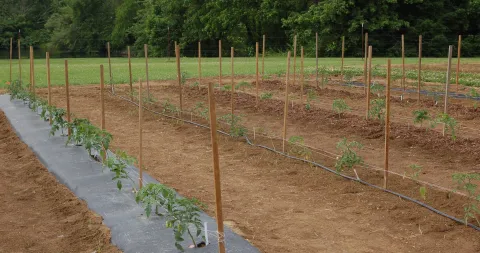Tomatoes Part II: Initial Fertilization & Mulching

In the first part of our tomato series, we discussed selecting the right variety of tomato for your garden and preferences. In this edition, we will talk about fertilization and one of the two biggest problems with growing tomatoes, weeds. Of course, being an Extension Agent, I must always recommend a soil test before planting your garden.
INITIAL FERTILIZATION
Tomatoes produce a significant plant and fruit biomass and require relatively large amounts of nutrients to achieve optimum productivity. Fertilizer will generally be applied before planting and during crop growth. The pre-plant fertilizer application often uses a complete fertilizer (one with all three primary macronutrients), such as 10-10- 10 or 6-12-12. Your soil test report will suggest fertilization materials and rates according to the balance of nutrients in the soil. Fertilizer should be evenly spread and incorporated or banded near transplant roots. Make sure not to apply chemical fertilizer where it can directly contact young plants because the high salt level can burn young roots or stems.
OPTIONS FOR PREVENTATIVE WEED CONTROL
Cultural practices
Weeds are one of the largest challenges in the home garden, so a combination of control measures is best. Cultural practices to prevent weed issues rely on removing annual weeds before they have a chance to mature and produce seeds. Likewise, perennial weeds may be physically pulled and should be completely removed to ensure that rhizomes (plant stems that can produce new weed plants) are not able to remain and cause additional problems.
Other practices that can reduce weed pressures in the home garden are mulching (discussed below) and appropriate uses of cover crops which can cover the ground and outcompete weeds. Solarization, or the heating of soil by covering with plastic sheeting, can also be a tool to reduce weed seeds and subsequent weed and disease issues. For more information about these weed control measures, contact us for additional resources.
CHEMICAL CONTROL
Herbicides are not often used in home gardens because of the low number of products available to consumers and the challenge in using these products in gardens where many crops are being produced across several seasons. Some pre-emergence (applied before weed seeds germinate) herbicide products may be useful if application rate and timing are carefully followed. Post-emergence products are more challenging to use because of their broad range of activity and the risk of overspray or drift onto garden vegetables. Additionally, tomato plants are one of the most sensitive crops to herbicide damage and can be severely harmed by small amounts of herbicide drift that may not damage other nearby crops. Use caution in managing any nearby lawn or garden area where there is any chance that spray drift or herbicide residue in soil could contact garden tomatoes.
MULCHING
Mulching materials, such as straw, leaves, grass clippings or compost can be applied after planting. When applied 3 to 6 inches thick, these mulches provide weed control for most annual weeds, moderate soil moisture levels, and reduce some disease problems. Organic mulches (from previously living things, not meaning USDA-certified organic) are often not applied at planting because they can cool early season soil temperatures by blocking sunlight from warming the soil. It may be best to apply them after the plants are established and soil temperatures have warmed. Organic mulches can be an asset in the heat of summer by moderating and cooling soil temperatures.
Inorganic or plastic mulches can also provide benefits to home garden tomato production. Black is the most common plastic color because it prevents weed growth while warming up the soil in the early season to aid in early growth. As with organic mulches, plastic mulches moderate soil moisture levels and also reduce some risks of leaf diseases by reducing soil splashed on leaves from precipitation. Install 4-foot-wide strips of plastic in the row area and seal the edges with about 6 inches of soil about two weeks before the planned transplanting date. Plastic mulch is a great addition to raised beds because the two methods increase early season drainage and soil warming. Install plastic after lime and fertilizer applications have been completed. It is essential to also install drip irrigation under the plastic mulch because it is impermeable to rainfall. Tomatoes are planted through slits cut in the plastic. Tomato stakes also can be driven through the plastic, but be careful to avoid the underlying drip line (see photo 1).
In the next article, we will discuss garden layout and planting techniques. For more information, please contact Shannon DeWitt, UT Extension Union County (865) 992-8038 or sdewitt@utk.edu
Written by Extension Agents: Shannon DeWitt, Anthony Carver, and Natalie Bumgarner.
- Log in to post comments